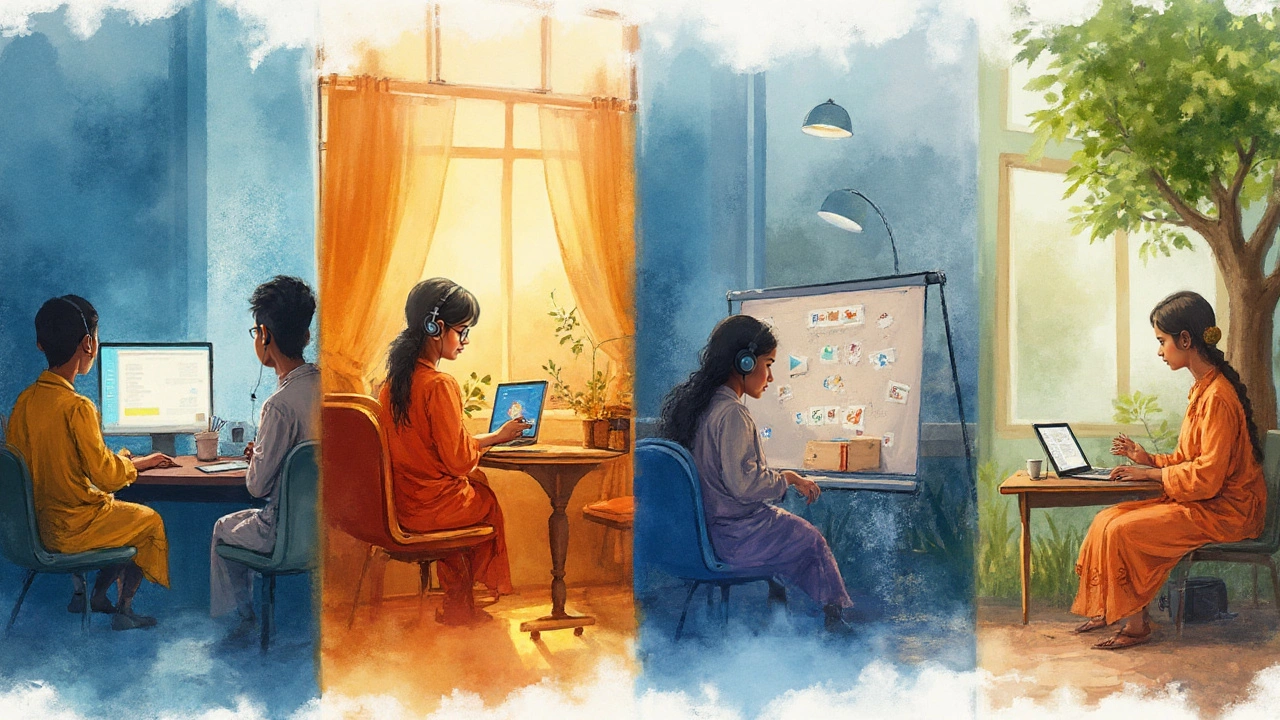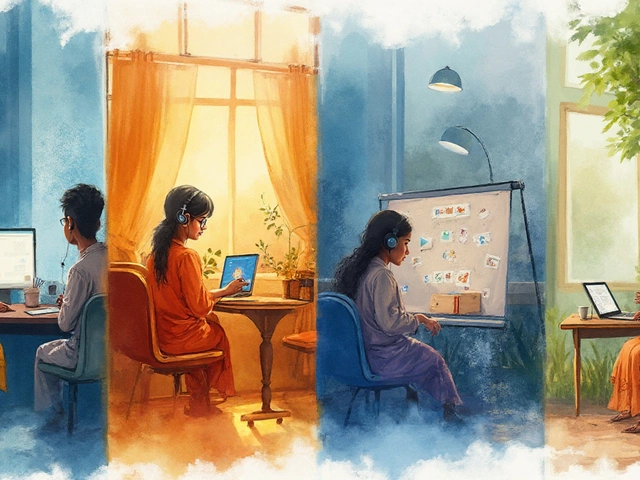You typed a simple question-what is eLearning called?-and fell into a sea of names: online learning, digital learning, distance education, ODL, blended, remote, virtual, mLearning. Same thing, different words? Not quite. The short answer: these terms overlap, but they aren’t identical. The longer answer: if you’re writing a policy, course page, resume, or sales deck, the term you pick signals the delivery model and the audience you serve. This guide clears the fog so you can label your learning format precisely and confidently.
- TL;DR: eLearning is the broad term for learning delivered through digital devices. “Online learning” is eLearning that requires the internet. “Distance education/ODL” is a regulated mode where students and teachers are separated by place (and often time), sometimes with online plus print or broadcast.
- Use “blended learning” when online and in-person are intentionally mixed. Use “remote learning” for temporary, emergency, or location-driven online classes (think pandemic-era setups). “mLearning” is learning on mobile devices, often micro-sized.
- In corporate settings, “eLearning” or “digital learning” and “e-training” prevail. In universities and government, “Online Learning” and “ODL” are common. In India, UGC formally uses “ODL” and “Online Learning (OL)” in its regulations.
- When in doubt, pick the term your audience expects: students and parents understand “online classes”; L&D teams expect “eLearning modules”; regulators expect “ODL/OL.”
- Quick rule: If it runs offline on an app or CD, it’s eLearning but not “online learning.” If it’s live on Zoom/Teams, it’s synchronous online learning; it’s also distance education if learners and teachers aren’t co-located.
What “eLearning” Is Called: Clear Definitions, Key Differences, and Where Each Term Fits
Let’s get the simple, working definitions on the table first, then we’ll get into nuance and usage so you can pick the right label without second guessing yourself.
- eLearning: Umbrella term for learning delivered via electronic devices-computers, tablets, phones. It can be online or offline. The term spread widely after the early 2000s via the U.S. Department of Defense’s ADL Initiative, which also drove SCORM and later xAPI standards. Many corporate L&D teams still default to eLearning as their house term.
- Online learning: eLearning that requires an internet connection-live classes, LMS-hosted modules, MOOCs, virtual labs. If it streams or needs web access, it sits here.
- Digital learning: A broad, modern label used by schools and companies. It covers online learning, device-enabled classroom work, simulations, AR/VR, apps, and digital content. It’s a safe choice if you want an inclusive, tech-forward tone.
- Distance education (Distance learning): A mode where learners and instructors are separated by location, often using online, print, TV/radio, and occasional in-person sessions. In India, the University Grants Commission (UGC) uses “Open and Distance Learning (ODL)” in formal regulations. UNESCO also uses “ODL” and “ICT in Education” across reports.
- ODL (Open and Distance Learning): A regulated distance mode with open entry/credit pathways, common in higher ed. In Indian policy (UGC, 2020 onward), “ODL” and “Online Learning (OL)” are distinct approval categories.
- Blended learning (Hybrid learning): A planned mix of face-to-face instruction and online components. If a course intentionally splits time between classroom and LMS/virtual sessions, it belongs here.
- Remote learning: A location-driven form of online learning. It often describes emergency or temporary arrangements (like pandemic-era schooling) but can also be permanent for distributed teams or students.
- Virtual learning: Often used for live sessions in virtual classrooms (Zoom/Teams/Meet) or 3D/VR environments. It’s informal outside of product marketing and school communications.
- mLearning (Mobile learning): Lessons designed primarily for phones and tablets-short, tap-friendly, often microlearning.
- CBT/WBT (Computer-Based Training/Web-Based Training): Older corporate terms. CBT was often offline (CDs, intranet). WBT is online via a browser. You’ll still see them in legacy documentation.
Now, how do people use these in the wild?
- Corporate L&D: “eLearning modules,” “digital learning academy,” “microlearning,” “compliance e-training,” “WBT.”
- Universities: “Online degree programs,” “ODL admissions,” “blended courses,” “MOOCs,” “virtual labs.”
- Schools: “Online classes,” “remote classes,” “digital classroom,” “hybrid schedule.”
- Government and policy: “Open and Distance Learning (ODL),” “Online Learning (OL),” “ICT in Education.”
Nuance worth knowing if you write for mixed audiences:
- If the course must meet regulations (credit-bearing degrees, public exams), “ODL” and “Online Learning” are safer and more precise than eLearning.
- If you’re selling B2B training, “eLearning” and “digital learning” signal corporate familiarity.
- If the learner is a parent or a K-12 student, “online classes” is clear and avoids jargon.
- If your program mixes campus weekends with online work, “blended learning” communicates design, not just delivery.
Style note: Big style guides differ, but here’s a pragmatic path used by many teams in 2025: write “e-learning” on first mention if your org is traditional or media-facing; “elearning” if your brand and audience skew tech or startup; “eLearning” if you follow product-style casing (common in L&D). Pick one, document it, and be consistent.
Credibility anchors for the careful reader:
- UGC’s 2020-2023 regulations separate “ODL” and “Online Learning (OL)” for Indian higher education approvals.
- UNESCO and OECD reports frequently use “ODL,” “online learning,” and “remote learning” to compare systems across countries.
- ADL (U.S. DoD) popularized the standards (SCORM, xAPI) that shaped how eLearning content is built and tracked in LMSs.

How to Choose the Right Term: A Simple Decision Tree, Style Guide, and Pro Tips
Here’s a quick way to land on the right label without overthinking it.
- Start with mode and location
Ask: Are teacher and learner in the same place?- Yes, same place: It’s face-to-face. If devices or LMS are part of it by design, call it “blended learning.”
- No, different places: It’s distance education. If the internet is involved, it’s online learning too. For regulated higher-ed programs, use “ODL” or “Online Learning” per approvals.
- Check connectivity
Ask: Does it require the internet?- Yes: Call it “online learning” (or “remote learning” if location-driven). It still sits under the eLearning umbrella.
- No: It’s eLearning that runs offline (apps, preloaded tablets, CBT). Avoid calling it “online learning.”
- Decide by audience expectations
- Corporate: Use “eLearning,” “digital learning,” “microlearning,” “WBT.”
- Universities/government (India): Use “ODL” and “Online Learning (OL)” in line with UGC language.
- Parents and K-12: “Online classes,” “remote classes,” “hybrid schedule.”
- Consider the learning design
- Live video with a teacher at a set time: “Synchronous online learning” (often remote learning).
- Self-paced modules on an LMS: “Asynchronous online learning” or “self-paced eLearning.”
- Mix of live and self-paced: “Blended learning” or “hybrid learning.”
- Write with a style you can sustain
- Pick one spelling-e-learning, elearning, eLearning-and stick to it across all pages.
- Capitalize program names (“Online BBA Program”) but keep generic terms lowercase (“online learning”).
- AP Style leans “e-learning”; many tech brands prefer “elearning.” Your brand voice matters more than winning the hyphen debate.
Rules of thumb you can trust:
- If a regulator is reading, choose “ODL/Online Learning.” If a buyer in HR is reading, choose “eLearning/digital learning.” If a parent is reading, choose “online classes.”
- If your delivery is mixed by design, call it blended learning. If you only moved online due to circumstances, call it remote learning.
- Short lessons on phones? mLearning or microlearning. Both are fine; microlearning is length-focused; mLearning is device-focused.
Common pitfalls to avoid:
- Calling everything “online learning” even when content runs offline (like SCORM packages in a local LMS or a mobile app with downloaded lessons).
- Using “ODL” casually when your program is not approved under ODL rules (matters in higher ed and in India in particular).
- Describing Zoom classes as MOOCs. MOOCs are open-enrollment, large-scale courses on platforms like Coursera, edX, SWAYAM, FutureLearn; Zoom is a delivery tool, not a course type.
- Mixing “hybrid” and “hyflex” as if they’re the same. Hyflex means students can choose to attend in-person or online each session; hybrid is a planned split of modes.
Mini style guide for teams:
- Preferred term: Choose one primary term for your site. Example for corporate: “digital learning.” Example for colleges: “online learning” for internet-based offerings; “ODL” for distance mode.
- First mention: Define once in simple words. Example: “Our online learning programs are taught live and via self-paced modules on our LMS.”
- Consistency: Keep the same term across titles, URLs, metadata, and body copy. Avoid “e-learning” in one section and “elearning” in another.
- Metadata tip: Include synonyms in alt text and meta descriptions for search (“online learning, digital learning, eLearning”).
Decision examples:
- A compliance course playable on a corporate LMS, self-paced: “eLearning module” or “WBT.”
- A degree with proctored exams, students off-campus, content via LMS plus self-instructional print: “ODL program.”
- A school running live classes via Google Meet, homework in Google Classroom: “remote online classes.”
- A bootcamp with weekend labs on campus and weekday lessons on an LMS: “blended learning program.”
- A sales academy delivering 5-minute phone-first lessons: “mLearning micro-courses.”

Examples, Checklists, and the Questions People Actually Ask
Concrete examples you can copy-edit for your context:
- University website (India): “This B.Com is offered in Online Learning (OL) mode as per UGC regulations. Some assessments are proctored remotely.”
- Corporate L&D page: “Our digital learning academy blends live virtual workshops with self-paced eLearning modules aligned to role paths.”
- School circular to parents: “Term 1 will run in a hybrid model: two days on campus, three days online via Microsoft Teams.”
- Resume (L&D professional): “Designed 25 microlearning modules (SCORM 1.2) for compliance; improved completion rates by 21%.”
- Training proposal: “We recommend a blended program: 3 live virtual sessions (2 hours each) plus 4 WBTs (45 minutes each) with mobile access.”
Cheat sheet: what to say when
- If it’s digital but you don’t want to be too techy: “digital learning.”
- If it’s on the internet: “online learning” (add “synchronous” or “asynchronous” if useful).
- If it’s formal, credit-bearing, off-campus: “distance education” or “ODL” per regulation.
- If it’s mixed with in-person: “blended learning” or “hybrid learning.”
- If it’s phone-first and short: “mLearning” and/or “microlearning.”
Quick checklist before you publish
- Have you matched the term to the delivery model (online vs offline vs blended)?
- Does the term meet any regulatory language you must use (ODL/OL)?
- Will your audience instantly understand it (parents vs L&D vs faculty)?
- Is the spelling consistent across the page/site?
- Did you label live vs self-paced if that matters for scheduling?
Glossary of related acronyms (the ones readers actually bump into):
- LMS (Learning Management System): Platform to host courses, enroll learners, track progress (e.g., Moodle, Canvas, Blackboard, Docebo).
- LXP (Learning Experience Platform): Pulls content from many sources, focuses on discovery, personalization, and social learning (e.g., Degreed, EdCast).
- LCMS (Learning Content Management System): Tools for authoring and managing learning content at scale.
- SCORM/xAPI: Technical standards that let your LMS track and report learning activity. SCORM is older and browser-based; xAPI handles wider activity (apps, simulations).
- MOOC: Massive Open Online Course-open enrollment, large scale, usually via platforms like SWAYAM, NPTEL, Coursera, edX.
Mini-FAQ
- Are eLearning and online learning the same? Not always. eLearning can be offline (like an installed app). Online learning requires the internet.
- Is a Zoom class eLearning? Yes, as part of online learning (synchronous). It’s also distance education because teacher and learner are in different places.
- Is ODL just a new name for distance education? ODL is distance education with an “open” ethos-flexible entry, varied media. In India, ODL is a formal, regulated mode under UGC.
- What’s the difference between blended and hybrid? Many use them interchangeably. If you need precision: hybrid = split between online and in-person; hyflex = students choose their attendance mode each session.
- Can I say “digital learning” for school students? Yes. It’s broad and parent-friendly, especially when learning mixes devices and classroom work.
- Do style guides agree on “e-learning/elearning/eLearning”? Not fully. AP often uses “e-learning.” Tech brands love “elearning” or “eLearning.” Pick one and be consistent.
- Are webinars considered online learning? Yes, webinars are a form of live online learning. If recorded for later, they become asynchronous content too.
- Is mLearning only microlearning? No. mLearning is about device; microlearning is about length. Many mobile lessons are micro, but not all.
- What should I put on my resume? Use the term your target employer uses: “Designed eLearning modules,” “Built online learning paths,” or “Led digital learning programs.” Mirror the job description.
- Is “virtual learning” the same as VR? Not necessarily. “Virtual learning” often means live classes in a virtual room. VR is a 3D environment. If you mean VR, say VR.
Next steps and troubleshooting for common scenarios
- If your committee can’t agree on a term: Run a quick test. Show three page versions to a small sample of your audience (students, parents, or managers). Ask which wording is clearest and why. Pick the winner and standardize it in your style guide.
- If your course runs both online and from a USB stick: Describe both. “Available as online learning and as an offline eLearning pack for limited-connectivity regions.” Clarity beats purity.
- If you’re in India and unsure between ODL and Online Learning: Check your approvals and UGC’s latest notifications. Use the exact terms tied to your recognition.
- If marketing wants “digital learning” but faculty insists on “online learning”: Split the difference. Use “digital learning” as a category label and “online learning” when you describe delivery.
- If parents complain about “remote learning” fatigue: Shift framing to “hybrid schedule” with clear timetables, or “live online classes + supervised study blocks.” The label can reset expectations.
A final sanity check for naming: If a stranger reads your page for 10 seconds, can they picture how the class actually runs-live or self-paced, on campus or at home, on a laptop or a phone? If yes, you chose the right term. If not, tighten the label and add one crisp sentence that spells out the mode.



